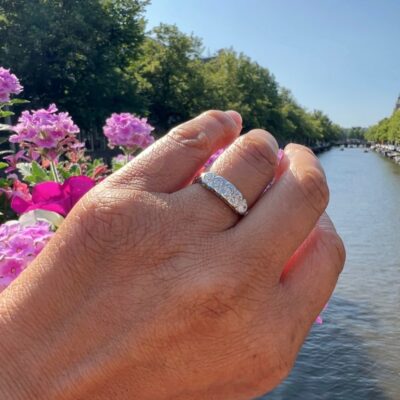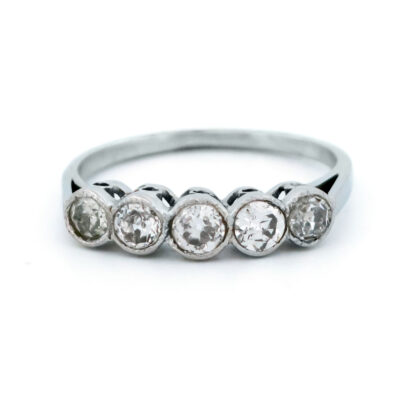This gorgeous early 20th-century (1910-1940) row ring features three old European-cut diamonds totaling approximately 0.65ct (J, VS1). Beautifully crafted in platinum, it captures the timeless elegance and craftsmanship of a bygone era.
Videos
Details: 3 totaling ±0.65ct (J VS1) Old-european-cut diamond, Platinum Ring.
Design Era: Early 20th Century (1910-1940).
Size: 17.93 NL / 56.3 FR / 7¾ US / P UK, sizeable (Within reason. Contact seller for information).
Dimensions: H 0.50 x L 1.5 x W 0.70 cm..
Weight in grams: 3,6.
Condition: Very good condition – slightly used with small signs of wear.
Shipping and Pickup: This gorgeous piece ships from our store located in the center of Amsterdam, The Netherlands. We offer both registered shipping and local pickup at our store. In the case of local pickup, any applicable shipping costs will be refunded.
About Us: Add some sparkle to your style with Binenbaum.com. We offer a stunning selection of antique and vintage jewelry that you won’t find anywhere else. From timeless rings and dazzling necklaces to unique brooches, we have something for every taste and occasion. Visit our website today and treat yourself to a piece of history.
| Design Era | |
|---|---|
| Design & Historical Context | During the 1910s to 1950s, the design of jewelry remained creative and stylish despite being impacted by economic and military events. Jewelry fashions during this time were influenced by various parts of the world, including the Near and Far East, and featured both exotic and geometric patterns that reflected the emergence of the machine age. New York became an important center for fashion along with Paris, and European jewelry companies had the opportunity to sell to and purchase from the Indian subcontinent. Art Deco jewelry, characterized by the use of numerous gemstones, was popular during this time, and the use of gold in jewelry increased in popularity due to its lower cost compared to platinum. Jewelry design also attracted artists and designers from various fields, giving hints about the direction that the industry would take in the future. |
| Key Materials | |
| Materials & Craftsmanship | Old-european-cut diamond: The Vintage Sparkle of Classic Romance Old European-cut diamonds are a beloved choice for those who appreciate vintage elegance and timeless beauty. This diamond cut, which was predominant from the late 19th century through the early 20th century, is known for its round shape, high crown, small table, and large, open culet. These characteristics give the stone a soft, romantic sparkle that evokes the charm of a bygone era. Historically, the Old European cut was the precursor to the modern round brilliant cut. It was crafted by hand, with each facet carefully shaped to maximize the diamond's brilliance under the softer lighting conditions of the time, such as candlelight. This cut was popular during the Victorian, Edwardian, and Art Deco periods, making it a favorite in antique and vintage jewelry. In modern jewelry, Old European-cut diamonds are highly sought after for their unique sparkle and historical significance. They often exhibit a warmer, more subdued brilliance compared to modern cuts, with an emphasis on depth and fire rather than the bright flashes of light seen in contemporary diamonds. This makes them ideal for engagement rings, earrings, and other pieces that celebrate vintage style and craftsmanship. An Old European-cut diamond is more than just a gemstone; it is a piece of history, reflecting the elegance and romance of the past. Its distinctive charm and enduring beauty make it a perfect choice for those who appreciate the artistry and nostalgia of vintage jewelry. Platinum: The Metal of Endurance and Prestige Platinum, a rare and precious metal, is renowned for its exceptional strength, purity, and enduring beauty. With its naturally white luster and remarkable resistance to tarnish and corrosion, platinum has become synonymous with luxury and durability in the world of fine jewelry. Historically, platinum has been valued for its rarity and unique properties. Ancient Egyptians and Pre-Columbian civilizations used platinum in their ceremonial jewelry, though its full potential wasn’t realized until the 18th century. By the 20th century, platinum became the metal of choice for royalty and high society, particularly in engagement rings and fine jewelry, due to its ability to securely hold precious gemstones. In modern jewelry, platinum is highly prized for its hypoallergenic properties and its ability to withstand daily wear without losing its brilliance. Its density and weight give it a luxurious feel, while its purity—often 95% pure—makes it an ideal setting for diamonds and other gemstones. Platinum's naturally white sheen enhances the sparkle of gems, and its durability ensures that jewelry pieces crafted in platinum can be passed down through generations. Platinum is more than just a metal; it is a symbol of strength, rarity, and timeless elegance. Its unmatched durability and sophisticated appearance make it the ultimate choice for those seeking jewelry that lasts a lifetime while maintaining its prestige and beauty. |
| Size | |
| Dimensions | H 0.50 x L 1.5 x W 0.70 cm. |
| Gender | |
| Weight (in grams) | 3,6 |
| Condition | Very good condition – slightly used with small signs of wear |
By following these tips, you can enjoy your precious jewelry for many years to come.
Related Products
-
Diamond Platinum Row Ring 11719-1973
€ 1.895,00 VAT incl. (where applicable) -
Diamond Emerald 14k Row Ring 17887-9322
€ 2.495,00 VAT incl. (where applicable) -
Diamond Platinum Row Ring 14454-7105
€ 1.695,00 VAT incl. (where applicable) -
Diamond Sapphire Platinum Row Ring 12327-2329
€ 2.695,00 VAT incl. (where applicable) -
Diamond 18k Platinum Toi Et Moi Ring 17320-9170
€ 1.895,00 VAT incl. (where applicable) -
Diamond 18k Row Ring 16733-8967
€ 5.895,00 VAT incl. (where applicable) -
Diamond Platinum Row Ring 385-0458
€ 1.695,00 VAT incl. (where applicable) -
Diamond 18k Row Ring 17759-9276
€ 2.295,00 VAT incl. (where applicable)
- Home
- Collection
- Fine Jewelry
- Silver Jewelry
- Silverware
- Boxes
- Candlesticks
- Salt and pepper shakers
- Miniatures
- Salt cellars
- Spoon Set
- Condiments
- Frames
- Napkin Ring
- Spoon
- Oddities
- Cups
- Vases
- Cutlery
- Serving Spoon And Cake Server
- Candlesticks
- Baskets
- Hanukkiah
- Spice Tower
- Yad
- Tea Set
- Sugar Castor
- Napkin Rings
- Wine Bottle Coaster
- Wine Stopper
- Tea Pot
- Jugs
- Rattles
- Hip Flask
- Miscellaneous
- Rings 💍
- About
- Contact























